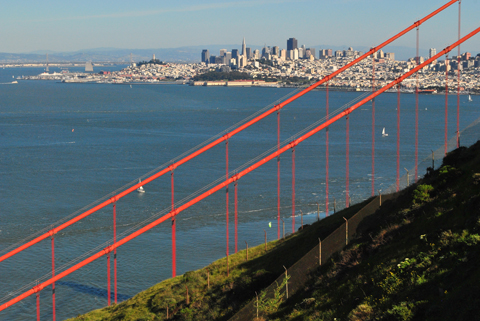Road Map: explaining the Natural Capital Project and refining our story
Back at school and shaking off the accumulated inertia of spring break, Julia, my co-blogger, and I sat down to talk about Science, Upstream. “We should post a blog soon, huh?” said Julia, looking more ready to play ultimate frisbee than start reporting. I reluctantly agreed. During our two weeks of traversing the country reporting for other projects, job hunting, attending weddings and finishing final exams, our blog about the Natural Capital Project had stayed quietly in the back of our minds, like the burble coming from the fish tank you know you need to drop feed into but figure it can wait another day or two.
But now, it had been too long. The fish seriously needed to be fed and the noise had boiled up to the front of our minds, nagging us both. But neither of us were prepared to sit down and produce something profound and informative.
The problem? The blog is about being “embedded” with a science team, and for the last two weeks we’d been the opposite of that. Meanwhile, a big question that had hung over us from the beginning loomed even larger, demanding to be answered:
How to make real a scientific endeavor that doesn’t take place in a lab and whose field locations are mostly too far-flung to reach — especially for poor, unfunded graduate students like ourselves? As we’ve written, NatCap brings together biologists and economists, computer scientists and policymakers. A lot of science happens, but most often on the computer or at a field site thousands of miles away. The project lacks exploding beakers, fights over lab space and other events that make for easy narratives.
Julia and I are happy with the profiles we’ve drawn, videos we’ve created, and pop-culture connections (link to Julia’s blog) we’ve drawn. But we’re still searching for ways to provide both more action and more clarity.
Julia plunged back into “the field” first. Today, she’s talking to one of the many women who lead NatCap. On Thursday, she’ll be posting another video — this one about the role women play in the NatCap project and the environmental sciences generally.
Meanwhile, I still hover a bit above it all, grappling with the question of how to explain this project. One challenge is figuring out who, and where, this dispersed, interdisciplinary and international project really is. We’ve found that the project is a web of disparate strands that intersect in a few key places. To better envision it, I created Natural Capital Visualized:
View The Natural Capital Project Visualized in a larger map
As Julia and I continue reporting this spring, the map will become rich with text and experiences. Stay tuned for a field trip to Monterey as we explore one of NatCap’s newest field sites with the scientists. There, NatCap scientists will be collaborating with the Nature Conservancy California and the Center for Ocean Solutions to test both the terrestrial model they’re known for and the marine model they’re unleashing. We hope to cap our reporting this May with a farther-flung field trip to Vancouver Island, where the project is testing some of its newest science.
Who is Science, Upstream?
 JAMIE HANSEN has written for Sierra Magazine, the High Country News, and Birders’ World. She’s pursuing a master’s degree in journalism at Stanford, hoping to tie together two passions: a keen interest in the natural world and communicating with broad audiences. She has a bachelor’s degree in English from Oberlin College, but fell in love with biology during her last semester.
JAMIE HANSEN has written for Sierra Magazine, the High Country News, and Birders’ World. She’s pursuing a master’s degree in journalism at Stanford, hoping to tie together two passions: a keen interest in the natural world and communicating with broad audiences. She has a bachelor’s degree in English from Oberlin College, but fell in love with biology during her last semester.
 JULIA JAMES is a master’s candidate in Journalism at Stanford University. She often writes about issues relating to human and environmental health. When not chained to a computer, she likes to climb rocks and chase Frisbees. She holds a B.S. in geological and environmental sciences (also from Stanford) and lives in Palo Alto with six housemates and five chickens.
JULIA JAMES is a master’s candidate in Journalism at Stanford University. She often writes about issues relating to human and environmental health. When not chained to a computer, she likes to climb rocks and chase Frisbees. She holds a B.S. in geological and environmental sciences (also from Stanford) and lives in Palo Alto with six housemates and five chickens.
